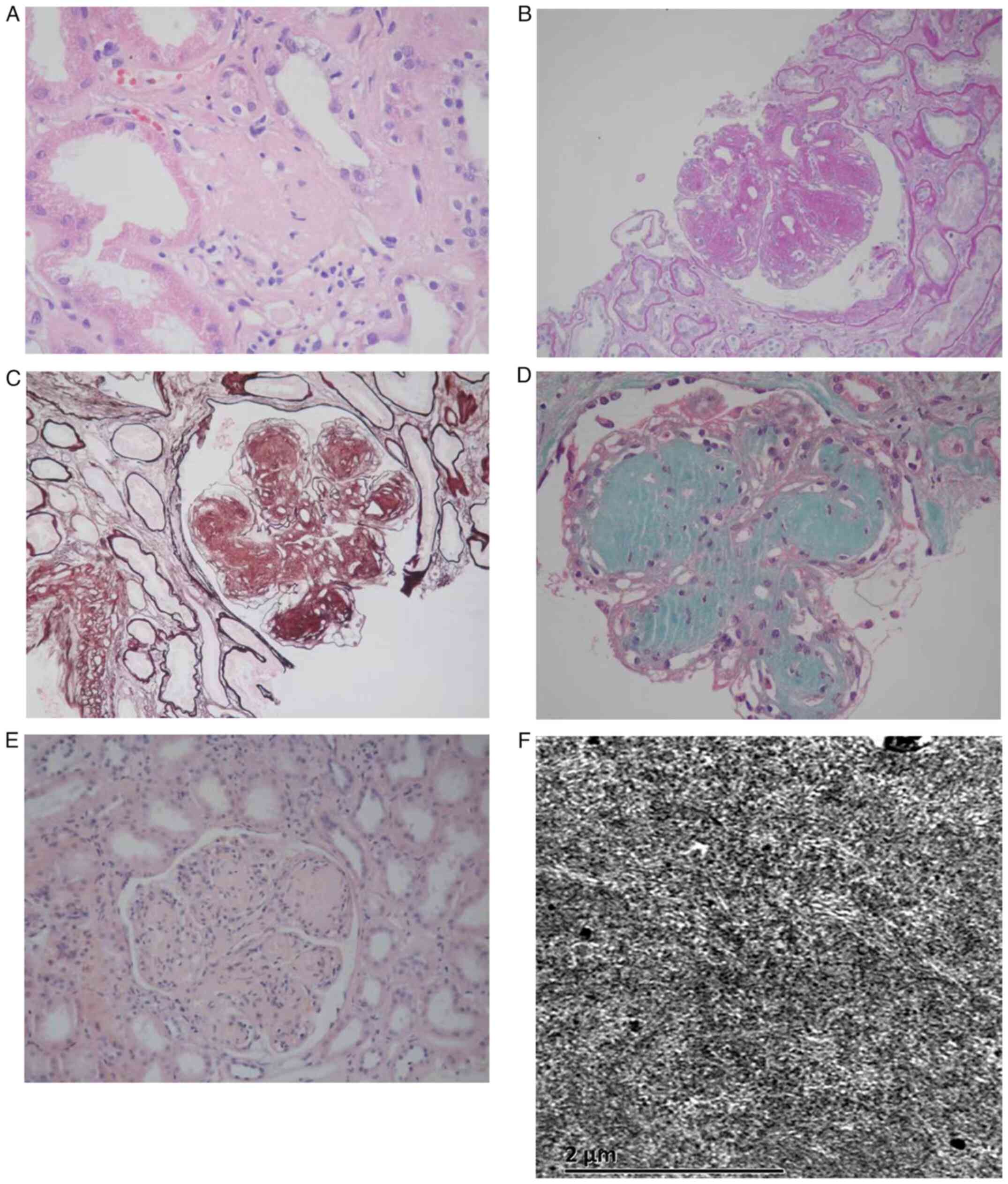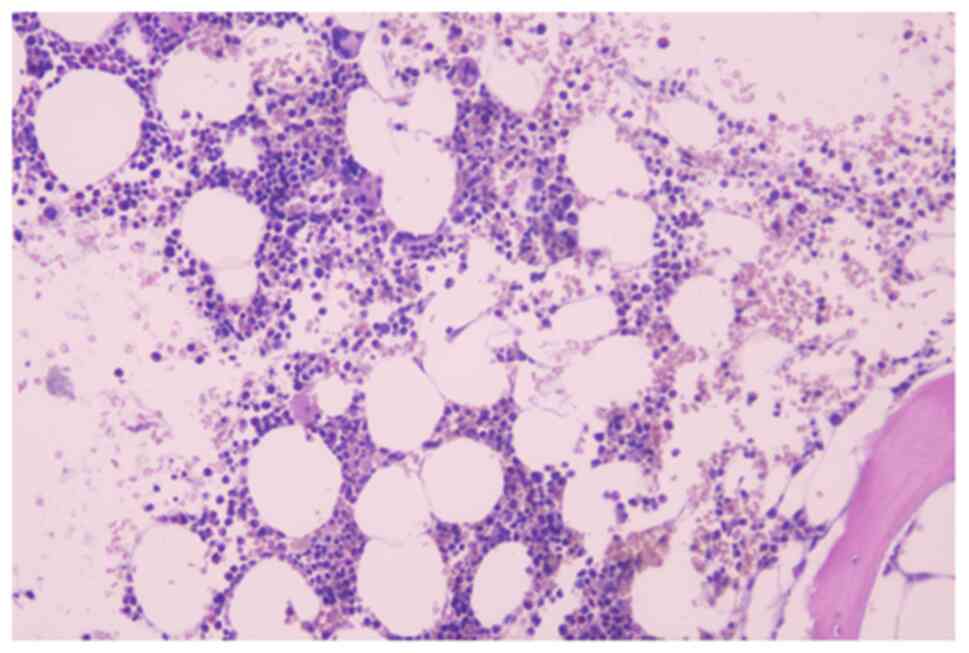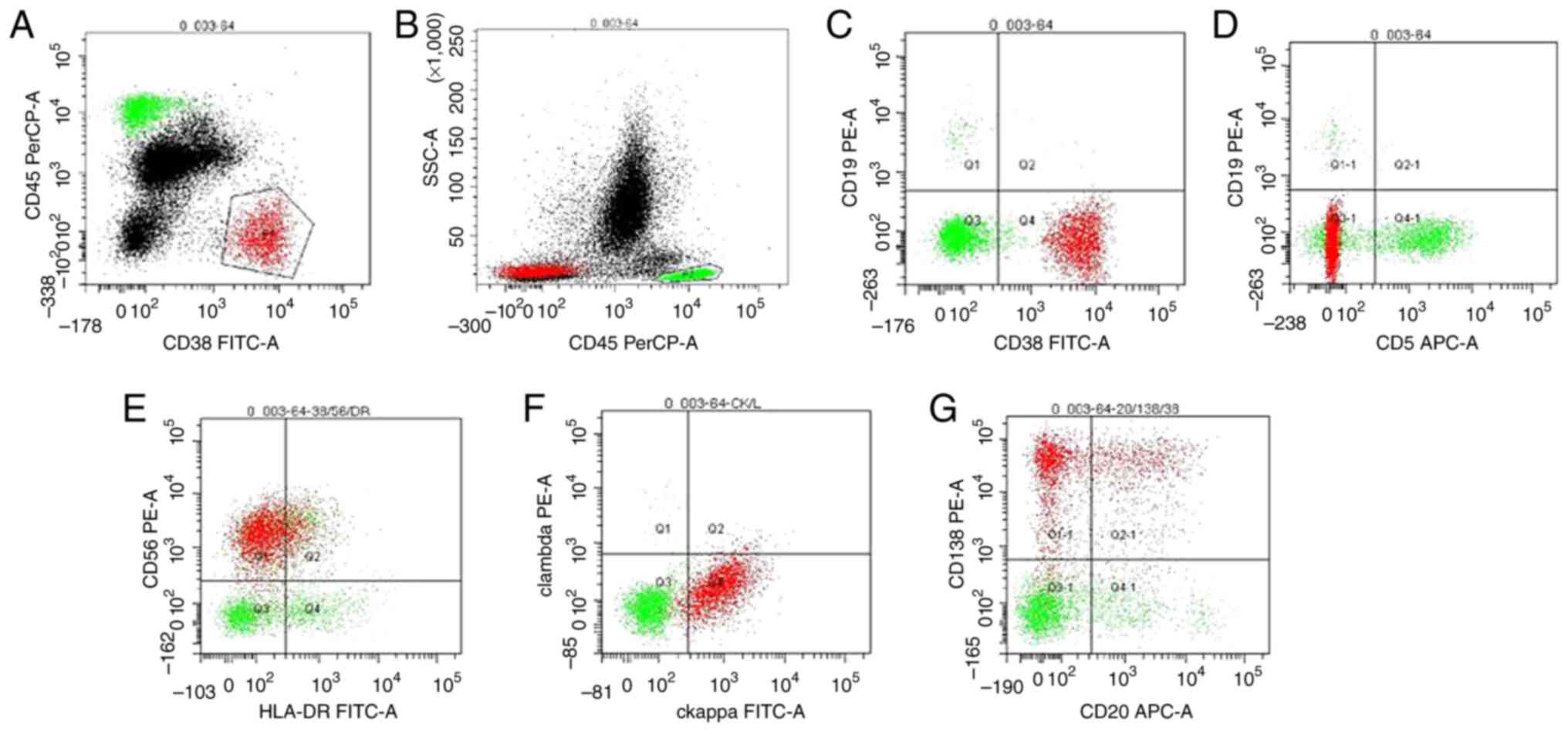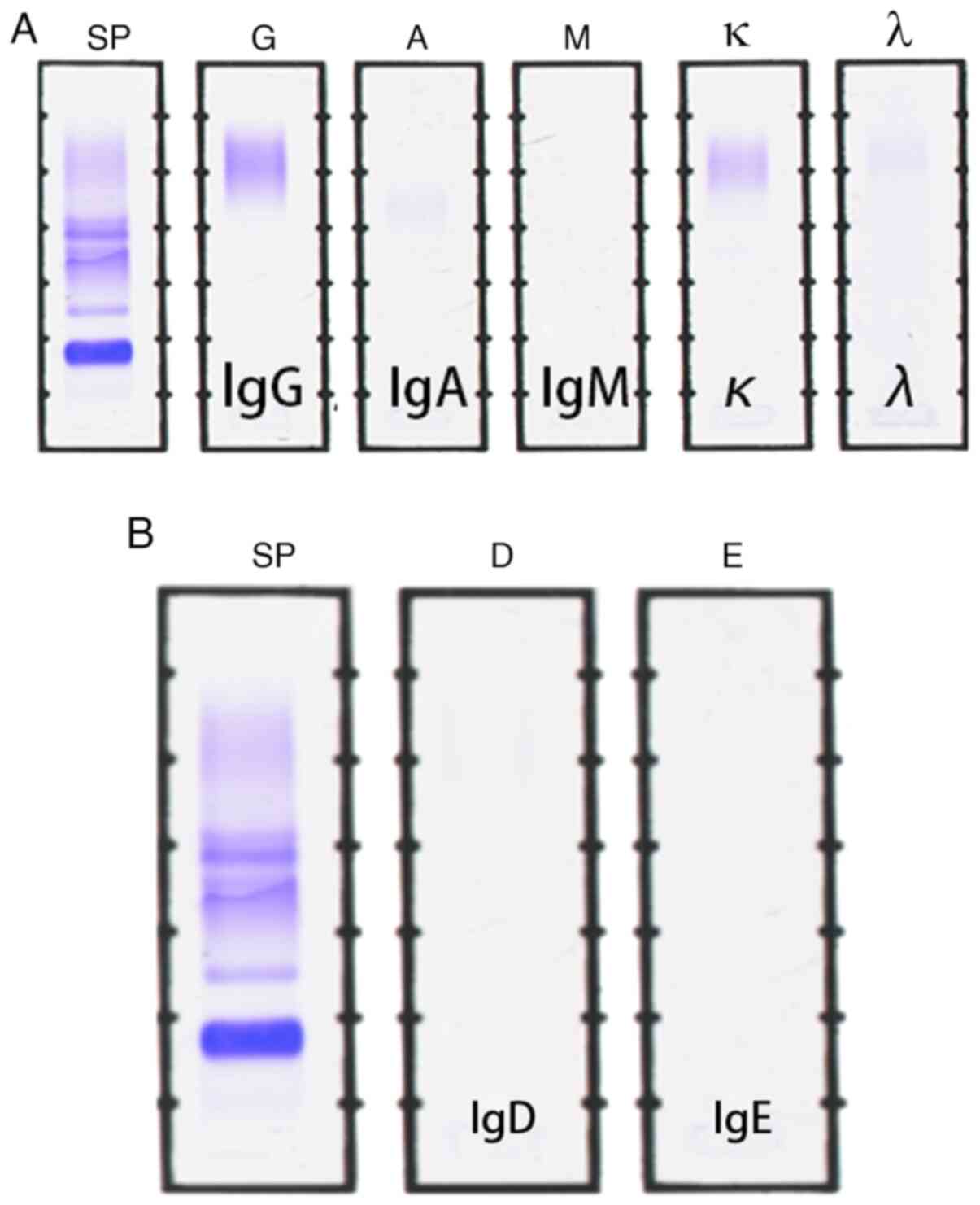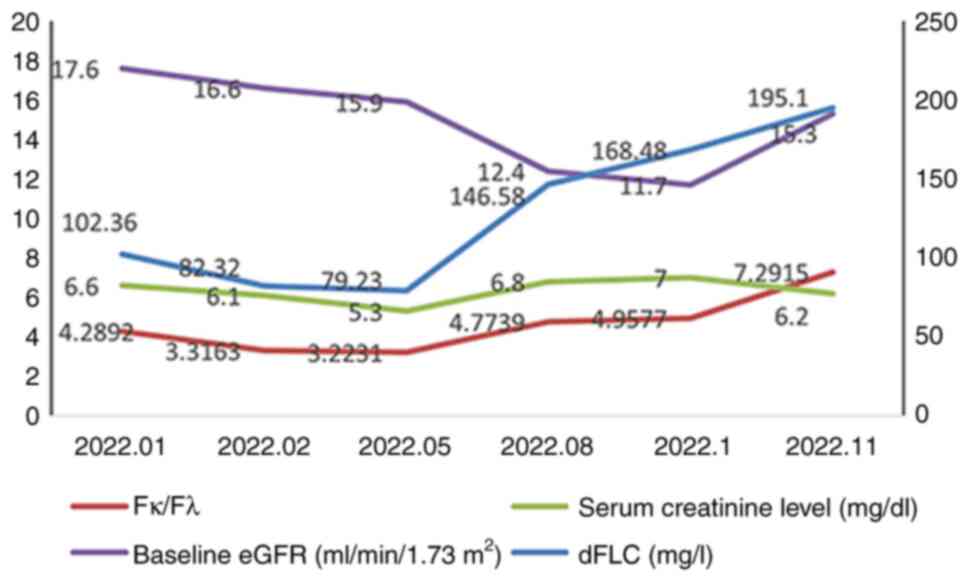|
1
|
Bisht K, Fukao T, Chiron M, Richardson P,
Atanackovic D, Chini E, Chng WJ, Van De Velde H and Malavasi F:
Immunomodulatory properties of CD38 antibodies and their effect on
anticancer efficacy in multiple myeloma. Cancer Med.
12:20332–20352. 2023.PubMed/NCBI View Article : Google Scholar
|
|
2
|
Arrossi AV, Merzianu M, Farver C, Yuan C,
Wang SH, Nakashima MO and Cotta CV: Nodular pulmonary light chain
deposition disease: an entity associated with Sjögren syndrome or
marginal zone lymphoma. J Clin Pathol. 69:490–496. 2016.PubMed/NCBI View Article : Google Scholar
|
|
3
|
Steward M, Yu JH and Gibbons MA: Sjögren's
syndrome as a cause of both lymphoid interstitial pneumonia and
light chain deposition disease in a single patient. BMJ Case Rep.
15(e249747)2022.PubMed/NCBI View Article : Google Scholar
|
|
4
|
Aoudia R, Bacha MM, Ounissi M, Gaied H,
Jerbi M, Abderrahim E, Abdallah TB and Goucha R: Monoclonal
gammopathy of renal significance with light-chain deposition
disease in kidney transplantation. Saudi J Kidney Dis Transpl.
30:1161–1165. 2019.PubMed/NCBI View Article : Google Scholar
|
|
5
|
Li W, Liang L, Liao Q, Li Y and Zhou Y:
CD38: An important regulator of T cell function. Biomed
Pharmacother. 153(113395)2022.PubMed/NCBI View Article : Google Scholar
|
|
6
|
Ye X, Zhao Y, Ma W, Ares I, Martínez M,
Lopez-Torres B, Martínez-Larrañaga MR, Wang X, Anadón A and
Martínez MA: The potential of CD38 protein as a target for
autoimmune diseases. Autoimmun Rev. 22(103289)2023.PubMed/NCBI View Article : Google Scholar
|
|
7
|
Holzer MT, Ruffer N, Huber TB, Kötter I,
Ostendorf L and Krusche M: Daratumumab for autoimmune diseases: A
systematic review. RMD Open. 9(e003604)2023.PubMed/NCBI View Article : Google Scholar
|
|
8
|
De Novellis D, Fontana R, Giudice V, Serio
B and Selleri C: Innovative anti-CD38 and anti-BCMA targeted
therapies in multiple myeloma: Mechanisms of action and resistance.
Int J Mol Sci. 24(645)2022.PubMed/NCBI View Article : Google Scholar
|
|
9
|
Kastritis E, Rousakis P, Kostopoulos IV,
Gavriatopoulou M, Theodorakakou F, Fotiou D, Dialoupi I, Migkou M,
Roussou M, Kanellias N, et al: Consolidation with a short course of
daratumumab in patients with AL amyloidosis or light chain
deposition disease. Amyloid. 28:259–266. 2021.PubMed/NCBI View Article : Google Scholar
|
|
10
|
Milani P, Basset M, Curci P, Foli A, Rizzi
R, Nuvolone M, Guido R, Gesualdo L, Specchia G, Merlini G, et al:
Daratumumab in light chain deposition disease: Rapid and profound
hematologic response preserves kidney function. Blood Adv.
4:1321–1324. 2020.PubMed/NCBI View Article : Google Scholar
|
|
11
|
Leung N, Bridoux F, Batuman V, Chaidos A,
Cockwell P, D'Agati VD, Dispenzieri A, Fervenza FC, Fermand JP,
Gibbs S, et al: The evaluation of monoclonal gammopathy of renal
significance: A consensus report of the International Kidney and
Monoclonal Gammopathy Research Group. Nat Rev Nephrol. 15:45–59.
2019.PubMed/NCBI View Article : Google Scholar
|
|
12
|
Kobayashi A, Takeda A, Shinjo H, Iguchi D,
Ito C, Okada E, Goto N, Futamura K, Okada M, Hiramitsu T, et al:
Light chain deposition disease recurrence in renal allograft after
long-term remission. Nephron. 147 (Suppl 1):96–100. 2023.PubMed/NCBI View Article : Google Scholar
|
|
13
|
Li J, Koerner J, Basler M, Brunner T, Kirk
CJ and Groettrup M: Immunoproteasome inhibition induces plasma cell
apoptosis and preserves kidney allografts by activating the
unfolded protein response and suppressing plasma cell survival
factors. Kidney Int. 95:611–623. 2019.PubMed/NCBI View Article : Google Scholar
|
|
14
|
Masood A, Ehsan H, Iqbal Q, Salman A and
Hashmi H: Treatment of light chain deposition disease: A systematic
review. J Hematol. 11:123–130. 2022.PubMed/NCBI View
Article : Google Scholar
|
|
15
|
Shimamura Y, Ogawa Y, Takizawa H, Hayashi
T and Sakurai Y: Light chain deposition disease diagnosed using
computed tomography-guided kidney biopsy. Cureus.
13(e15102)2021.PubMed/NCBI View Article : Google Scholar
|
|
16
|
Tsushima T, Suzuki T, Terao T, Miura D,
Narita K, Takeuchi M, Shimuzu A and Matsue K: Light chain
deposition disease involving kidney and liver in a patient with IgD
myeloma. BMC Nephrol. 22(40)2021.PubMed/NCBI View Article : Google Scholar
|
|
17
|
Heybeli C, Alexander MP, Bentall AJ, Amer
H, Buadi FK, Dean PG, Dingli D, Dispenzieri A, El Ters M, Gertz MA,
et al: Kidney transplantation in patients with monoclonal
gammopathy of renal significance (MGRS)-associated lesions: A case
series. Am J Kidney Dis. 79:202–216. 2022.PubMed/NCBI View Article : Google Scholar
|
|
18
|
Nambirajan A, Bhowmik D, Singh G, Agarwal
SK and Dinda AK: Monoclonal gammopathy of renal significance with
light-chain deposition disease diagnosed postrenal transplant: A
diagnostic and therapeutic challenge. Transpl Int. 28:375–379.
2015.PubMed/NCBI View Article : Google Scholar
|
|
19
|
Kuppachi S, Holanda D and Thomas CP: Light
chain deposition disease after kidney transplantation with long
graft survival: Case report. Transplant Proc. 48:255–258.
2016.PubMed/NCBI View Article : Google Scholar
|
|
20
|
Jimenez-Zepeda VH, Vajpeyi R, John R and
Trudel S: Light chain deposition disease affecting the
gastrointestinal tract in the setting of post-living donor kidney
transplantation. Int J Hematol. 96:125–131. 2012.PubMed/NCBI View Article : Google Scholar
|
|
21
|
Tanenbaum ND, Howell DN, Middleton JP and
Spurney RF: Lambda light chain deposition disease in a renal
allograft. Transplant Proc. 37:4289–4292. 2005.PubMed/NCBI View Article : Google Scholar
|
|
22
|
Larsen T, Hammer A and Jørgensen KA:
Recurrence of light-chain deposition disease after renal
transplantation. Scand J Urol Nephrol. 42:187–188. 2008.PubMed/NCBI View Article : Google Scholar
|
|
23
|
Ecder T, Tbakhi A, Braun WE, Tubbs RR,
Myles J and McMahon JT: De novo light-chain deposition disease in a
cadaver renal allograft. Am J Kidney Dis. 28:461–465.
1996.PubMed/NCBI View Article : Google Scholar
|
|
24
|
Horike K, Takeda A, Otsuka Y, Inaguma D,
Goto N, Watarai Y, Uchida K and Morozumi K: A case of recurrent
light chain deposition disease after living-related renal
transplantation-Detailed process of the recurrence. Clin
Transplant. 26 (Suppl 24):64–69. 2012.PubMed/NCBI View Article : Google Scholar
|
|
25
|
Taneda S, Honda K, Horita S, Koyama I,
Teraoka S, Oda H and Yamaguchi Y: Light chain deposition disease
after renal transplantation. Am J Kidney Dis. 52:621–625.
2008.PubMed/NCBI View Article : Google Scholar
|
|
26
|
Ziogas DC, Kastritis E, Terpos E, Roussou
M, Migkou M, Gavriatopoulou M, Spanomichou D,
Eleutherakis-Papaiakovou E, Fotiou D, Panagiotidis I, et al:
Hematologic and renal improvement of monoclonal immunoglobulin
deposition disease after treatment with bortezomib-based regimens.
Leuk Lymphoma. 58:1832–1839. 2017.PubMed/NCBI View Article : Google Scholar
|



